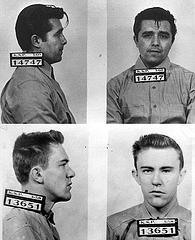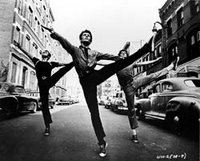



1. Although you might not notice it with Philip Seymour Hoffman mincing all over the screen (brilliantly, yes) Perry and Dick are a very intimate pair.
2. This is way more obvious in the book
In Cold Blood, or in the film
In Cold Blood. Both of which are about Dick and Perry and "not" about Capote in the same way that the film
Capote is about Capote and "not" about Dick and Perry. With a lot of attention to Dick's good looks. He looks just like a boy I held a torch for in high school. Everyone did. The "All American Boy" as he puts it.
3. I'm not saying cinematic or literary Perry and Dick are gay or homosexual or queer, but I think anyone looking at (a) the language of the book, (b) the conventions of the movie
In Cold Blood and (c) the historical and biographical information given in the movie
Capote might be able to make an argument that all three works are about (or maybe only participate in, but I'd say they are critical of) the common equation of queer with pathological in the US in the middle of the century. And a resistence to this. To make this argument I'd to draw on the work of Michael Rogin, not the race stuff, the queer Cold War stuff, on
Manchurian Candidate. Which was just remade too, with some ironic attention to race . . .
4. In the film
In Cold Blood there is a scene in the car, a similar scene occurs in the book too (44), but when I first read and saw this story, the car scene in the film hit me harder. Perry and Dick are talking about prison and, I think, Perry's friend Willie-Jay and Dick launches into a harsh string of insults, including but not limited to, "real faggot." I feel like this is like Dick is claiming, "I'm not queer," that is, marking the unique meaning of one's own romance against the names it might be called by the outside world . . .
5. As for the "western" angle, I've got a working hypothesis, that I haven't really taken the time to prove, that the road movies of the 60s and 70s were related, generically, to westerns. I'm sure I'm not the only to claim this, but, like I said, I haven't done any research on this one. Visually, I'd say,
In Cold Blood might be considered a western . . . .
6. And then there is the
Treasure of the Sierra Madre. I've already explored the parallels between that and this years most famous queer western.
7. The actor who plays Perry in the film
In Cold Blood supposedly played the Mexican kid in
The Treasure of the Sierra Madre, the one who sold Bogart and his buddy the winning lottery ticket that enabled them to go on their prospecting trip. The film
In Cold Blood mentions the film
Treasure of the Sierra Madre. And the film also mentions various Mexico schemes (Perry and Dick make it to Mexico, but return to Kansas to be caught) including one that is suggested by a shoeshine boy, a boy who, Perry muses, they'd have to cut in on the takings, if the scheme worked out. FYI, no one considers cutting Mexican boy in in the film
Treasure of the Sierra Madre. And the shoeshine boy doesn't appear in the book
In Cold Blood, I don't think.
8. But on page 15 of
In Cold Blood, Capote spells it out for us - read this story as one in a long line of queer western tragedies. Perry is looking at his map of Mexico,
"Sierra Madre meant gold, meant
Treasure of the Sierra Madre, a movie he'd seen eight times. (It was Bogart's best picture, but the old guy who played the prospector, the one who reminded Perry of his father, was terrific too. Walter Huston. Yes, and what he had told Dick was true: He did knwo the ins and outs of hunting gold, having been taught them by his father, who was a professional prospector. So why shouldn't they, the two of them, buy a pair of pack horses and try their luck in the Sierra Madre? But Dick, the practical Dick, had said, 'Whoa, honey, whoa. I seen that show. Ends up everybody nuts. On account of fever and bloodsuckers, mean conditions all around. Then, when they got the gold - remember, a big wind came along and blew it all away?') Perry folded the map."
Top left: Perry and Capote from
Capote. Top right: real, historical Capote.
Center: Real, historical Perry top, real historical Dick bottom.
Bottom: Perry right and Dick left from
In Cold Blood film.
Categories: film, visual, material, book, literary
 Seafood Shortcake. Or, a scone with tomato fish sauce.
Seafood Shortcake. Or, a scone with tomato fish sauce. 











